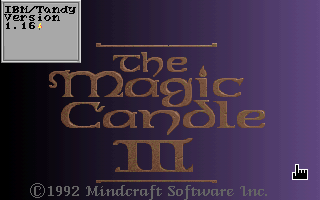From The CRPG Addict
The Magic Candle III
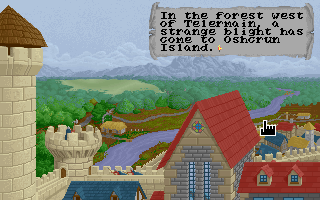 |
| Dutch Elm Diseases is rarely a setup for an epic adventure. |
You’ll remember that in The Magic Candle (1989), the protagonist and his (later retconned to “his or her”) party of locals scoured the land of Deruvia to find the items and rituals necessary to renew the magic prison (a candle) of the demon Dreax. In ancient times, Dreax had come across the sea from Gurtex with an army of invaders, but he had been bound to the candle by a ritual created by the now-mostly-lost race of Eldens. After the party’s success in the first game, King Rebnard of Deruvia decided he was sick of living in fear of the demon lords of Gurtex. He gathered his armies and took the fight to them, crossing the ocean and landing on Oshcrun Island–on the way, conquering the island of Maramon as told in The Keys to Maramon (1990).
 |
| A map of the “Solian Lands.” |
In The Magic Candle II (1991), the hero of either the first game or Maramon or both continued the effort by helping the invasion of Gurtex from Oshcrun. At first just interested in discovering the fate of the “four and forty” guardians of the original candle, the party ended up rescuing Prince Jemil, Rebnard’s son, from the clutches of the demon Zakhad. While the demon himself was immortal, Jemil was able to send him “far, far away” using a magic orb. (The plot ended up getting pretty ridiculous by the end, which you can see in my entry on winning that game.)
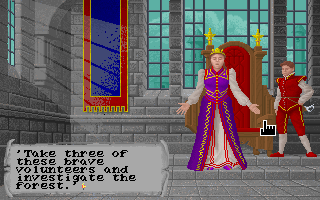 |
| The queen kicks off the quest. |
The import process works very well, almost too well. “Gia” came through from The Magic Candle II with none of her attributes or skills reduced. Her average attribute is 9.4 versus 6.8 for a newly-created character. She comes with magic weapons and armor, plus 1000 coins instead of a new character’s 500. She has practically a full set of spellbooks. More important, many of her skills are already maxed or near-maxed, including 99/99 for “Sword,” 70/80 for “Archery,” 87/99 for “Researching,” and 50/99 for “Leadership.” Later, after they joined my party, I discovered that other NPCs who were still with me at the end of II also retained their equipment, attributes, and skills.
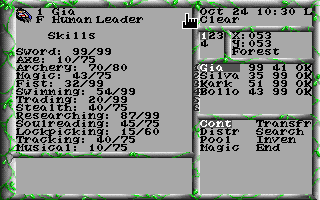 |
| None of Gia’s skills were diminished by the intervening years. |
The game opening gives you the option to pick 3 of 8 potential volunteers. I was in the midst of evaluating their strengths and weaknesses when, I don’t know, I hit the wrong key or something and ended up with Silva, Kark, and Bollo by default. I decided to just roll with it.
We started in the middle of a dark, twisty forest, with a skeleton on the ground in front of us. As we began to move around, one major change from the previous two games became clear: the Magic Candle III party happily takes itself out of formation to get around obstacles and to conform to narrow passages, instead of requiring the player to micro-manage the formation to, for instance, make the lead character poke out one square so he can search a 1 x 1 area. To be fair, The Magic Candle II managed to make something of a game of the formations, requiring the player at various points to figure out the most convoluted formation necessary for navigating a trap-filled hallway. Still, I’m glad to be done with it.
As we walked along the path, we were ambushed by a group of “Blightmolds” and “Blightworms.” An orc named Garz stepped out of the trees to join the party’s attack against the creatures.
 |
| The combat screen. |
Combat takes place on the same tactical, turn-based screen as the previous games, with each character getting a certain number of actions dependent on his or her movement points. Combat seems a bit more streamlined here, and more in the Ultima VI mold. There’s no pre-combat round, no positioning of characters, and less distinction between the exploration environment and the combat environment. Then again, I might just be noting the distinction between wilderness combat and “room” combat in the last game. I’d have to fight a few battles to check. I’ll have more on combat details later.
The battle was pretty easy. At its conclusion, “Garz” introduced himself more properly as Garzbondgur, Crown Prince of Kabelo. He said that his land has been affected badly by the same blight, and that he came to Oshcrun to ask for my assistance. Just as I was wondering where “Kabelo” was, he continued that his father had forbade the trip, as the people of the “Solian Lands” don’t normally trust “northern folk.” I don’t know if any previous Magic Candle had addressed these “Solian Lands,” but I don’t think so. It’s the first major crack–the idea that a large collection of landmasses could lie south of Oshcrun and have gone unmentioned in the previous game.
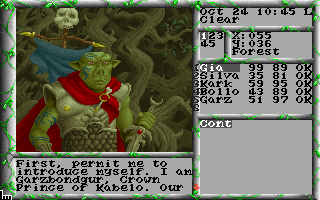 |
| A suitably orcish-looking orc. |
Garz remained a member of the party as we continued on. (For some reason, the game asks me to explicitly confirm that I want to include him when I distribute things to the party.) We met some more worms in a battle that left three characters poisoned, so I had to look up what mushroom cures poison (Loka). Fortunately, the game started me with a few of them, as well as a few memorized “Healing” spells. A third battle gave us “Blightboars” as well as molds and worms.
Pretty soon, we were out of the forest and on to the Oshcrun overworld map. Nearby were Oshcrun Castle and the city of Telermain.
 |
| Between the castle and the city. |
I entered the castle first. Instead of the sprawling, multi-storied structure that I could explore on my last trip, for this game (or, at least, this trip), I was confined to the throne room. There, I had a lot of trouble distinguishing people from furniture. The conversation proceeded much as in previous games, through the “Greet” and “Talk” commands. As usual, the game offers some stock selections while allowing the ability for the player to type in a keyword to ask about a specific subject or person.
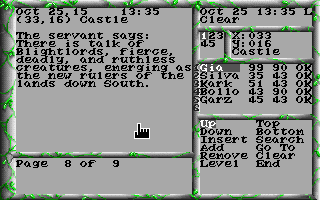 |
| Stop being so dramatic, Carl. It’s called “jock itch.” |
Almost immediately, a servant said that, “There is talk of Blightlords, fierce, deadly, and ruthless creatures, emerging as the new rulers of the lands down south,” thus providing me with more intelligence than the entire backstory and summary of the problem given by Queen Alishia.
A notepad stores all of your major observations and conversations, and it’s been significantly improved. It no longer erases when you quit and restart the game; it lets you add pages to type your own notes; and it has a “Search” feature. This might be the first game where you can do all your documentation in-game.
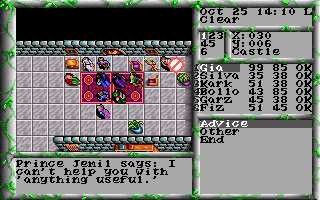 |
| The throne room. Jemil is as helpful as ever. |
Two companions joined my party in the throne room, replacing two of the rank amateurs who had accompanied me to the forest. (I assume you can keep them if you want, but their skills are in the single digits.) Rimfiztrik the Wizard and Sakar the Dwarf I remember well from previous games. A third potential companion named Marsa offered to join, claiming to be skilled in the martial arts, but she’s a hireling who you have to keep happy with gold, so I declined to take her. In inviting himself to join the party, Sakar noted that the Solian lands are dangerous and I’d need a good fighter at my side. I guess everyone in this game knows where I’m going but me.
In contrast to the castle, Oshcrun was as large and complex as I remembered it, with numerous NPCs and shops, and their availability changing depending on the time of day. I think they may have kept the same map from The Magic Candle II; at least, most things were where I remembered them. I stocked everyone up on food and bought some mushrooms and potions. I’m a little annoyed that the third edition still hasn’t fixed the pooling/distribution problem. (Since no character can pool more than 99 of most things, there’s no way to evenly distribute all of a particular resource once you earn above 99 of them.) It would have been nice if the developers had regarded food, mushrooms, and gold as party resources rather than individual resources.
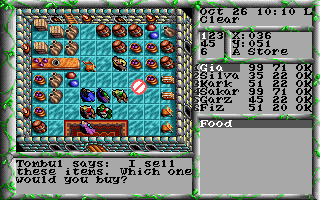 |
| Buying individual food in the shop. |
As with the first two games, there are locked houses at which you can knock at the door, but you have to have some clue as to the occupant’s name. There are trainers and tradesmen where you can ditch party members to learn or work for a wage. I soon found Eneri, my hero from Maramon, in the Eastern Breeze tavern, so I ditched the novice Kark b’Dang at the metalsmith, as he had some skill in that area, to make money for us to take later. This always feels a little mean.
 |
| For some reason, the Maramon character appears as “Ralle” until he or she joins the team. |
I saved selling my gems and purchasing any weapons or armor for later, deciding to explore the rest of the island first. I soon remembered how quickly stamina runs out in the wilderness. You basically have to have everyone chew Sermin mushrooms every dozen steps or so. What particularly sucks is that energy depletes at inconsistent rates for the characters, so that when some of them get to 0 others are still in the 60s. But unless you want to micromanage levels for each character, you just have everyone eat at once, wasting a lot of potential energy.
I found the stronghold on Oshcrun (places where you can rest safely and send party members), and then a “brick building” with a much more elaborate teleportal than I remember from the previous games, and then finally the little halfling town of Ketrop. A mayoral election was underway between candidates named Miko and Punnik, but that didn’t develop into anything. I replaced Silva with a more experienced halfling named Tuff; he seemed to remember Gia, though I don’t remember him from the previous game.
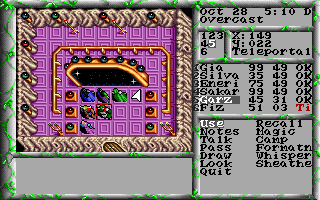 |
| The teleportal chambers look more high-tech than before. |
 |
| Making landfall on a strange, southern shore. |
We soon made landfall on a large island. The journey was quick enough that it defies logic that these “Solian Islands” are being mentioned here for the first time. The island turned out to be the island of Kabelo on the game map. This is Garz’s kingdom, and indeed as soon as I entered the first city I saw on the island, Garz welcomed us to Urkabel.
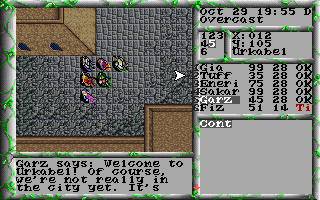 |
| Garz jumps the gun (apparently) in welcoming us to his home city. |
I think I’ll leave off there for my first session. So far, it’s been a pleasant game, but with all the weaknesses of the Magic Candle II engine in addition to the strengths. I should have a stronger opinion after a few hours of combat and dungeon exploration.
Time so far: 4 hours
Original URL: http://crpgaddict.blogspot.com/2019/09/game-339-magic-candle-iii-1992.html

